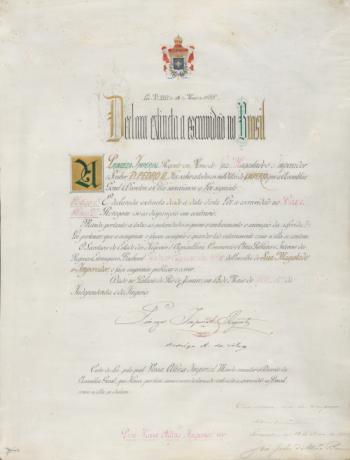A Golden Law received its name as part of a narrative that sought to exalt the law that abolished slaves in May 13, 1888. This same narrative sought to exalt abolition as a benefactor of the monarchy, presenting Princess Isabel as a redeemer of blacks in Brazil. This narrative, however, erases the protagonism of blacks in the abolitionist struggle.
The abolition of slavery, contrary to what this narrative suggests, was the result of the struggle of the slaves themselves against slavery, through revolts, escapes, etc. Furthermore, the strength of the abolitionist movement and popular support for the cause contributed to the definitive abolition of slavery.
Read too: Six curiosities about Princess Isabel
Summary
The term “aurea” in the name of Lei Áurea is a reference to gold and the idea that the law that abolished slavery was something glorious.
This idea is part of a narrative that established the Lei Áurea as the result of an improvement by the monarchy.
This narrative is not supported by historiography, which understands that abolition was a popular achievement.
This conquest was the result of the resistance of the slaves and the engagement of the abolitionist movement.
Why was the Lei Áurea given its name?

The Lei Áurea, as it is commonly known, or Law nº 3.353, of May 13, 1888, was the law that determined the abolition of slavery in Brazil. O The term “golden” is defined in the dictionary as something that is related to gold.. The purpose of this association was to convey a positive image of the law, as a great achievement, a great benefit of the monarchy and something glorious.
The use of the term followed a logic that established the Lei Áurea as a demonstration of the greatness and goodness of the monarchy for having abolished slavery in Brazil. This memory determined the abolition as an achievement obtained by merit of the monarchy. Furthermore, this memory established Princess Elizabeth as a redeemer, responsible for saving thousands of people from slavery.
The term “golden”, therefore, was part of a narrative constructed to seek to enhance the monarchy and the members of the Brazilian royal family as the main responsible for the abolition of slavery. This narrative had a lot of space in historiography until the 1970s, but it was deconstructed by new studies.
Context of the abolition of slavery and the Lei Áurea
Unlike what was established by this narrative, the abolition of slavery was not the result of a benefactor of the monarchy, nor of the generosity and altruism of Princess Isabel. This narrative, in fact, hides the protagonism of blacks and the Brazilian population itself in the fight against slavery.
A abolition of slavery was signed by Princess Isabel, then Princess Regent, on 13 May 1888. The law was greeted with celebration by a large part of the population, and popular celebrations lasted for days in large cities, such as Rio de Janeiro. Through the Lei Áurea, more than 720,000 slaves were freed, and their former owners were not compensated.
The Golden Law decree was the conclusion of decades of struggle of the abolitionist movement and a centuries-old resistance of slaves against slavery. The strength of the abolitionist movement increased considerably from the 1870s onwards. The national and international scenarios gave strength to the movement to abolish slavery.
Abolitionists organized themselves in large cities and held meetings and rallies defending the end of slavery in Brazil, disseminated leaflets, published books in defending the cause, acting legally to ensure that slaves were freed, encouraging escapes, sheltering runaway slaves, providing them with food and transportation etc.
Slaves, in turn, intensified their struggle against slavery. A slave resistance against slavery existed from the moment this institution was established in Brazil. You slaves rebelled, refused to work, ran away, formed quilombos. In the second half of the 19th century, the situation became untenable.
The escape of slaves and the formation of quilombos became frequent, and large quilombos emerged around the cities of Santos and Rio de Janeiro, for example. These runaway slaves relied on help from the abolitionist movement and the civilian population, and many were looking for ways to escape to Ceará or Amazonas, states that had abolished slavery in 1884.
Read too: Symbolic difference between Abolition Day and Black Consciousness Day
Why was the Lei Áurea actually sanctioned?
The strength of the abolitionist movement made significant portions of the civilian population embrace the cause of the abolition of slavery. By the end of the 1880s, the abolition of slavery was inevitable because:
there was fear with the continuous escapes and revolts of the slaves;
it was feared that the dispute would lead to a civil war, as happened in the United States;
Brazil was the only country in the West that still maintained slavery;
the defense of agrarian reform advanced alongside the abolitionist cause.
Thus, the strength of the abolitionist movement, the fear of an internal conflict and the agrarian reform made the economic elites agree with the abolition. Popular struggle and black protagonism, not the kindness of the monarchy, ended slavery in Brazil.
By Daniel Neves Silva
History teacher
Source: Brazil School - https://brasilescola.uol.com.br/curiosidades/por-que-a-lei-aurea-se-chama-aurea.htm
